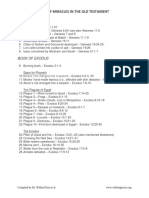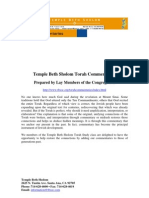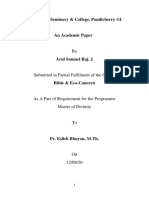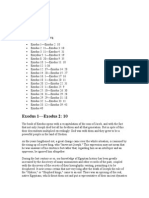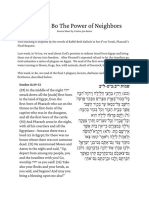0 ratings0% found this document useful (0 votes)
73 viewsExodus
Exodus
Uploaded by
ninaThe document summarizes the biblical story of Moses and his mission to free the enslaved Jews from Egypt. It describes how Moses was banished to the desert as a boy and later accepted God's call to free His people. Despite warnings from Moses, the Pharaoh Ramses refused to believe in God or free the Jews. In response, God inflicted 10 plagues on Egypt, culminating in the death of the firstborn. Ramses then let the Israelites go but pursued them with his army until God parted the Red Sea to allow Moses' people to escape. The document also notes some differences between the biblical account and its portrayal in the film Exodus: Gods and Kings.
Copyright:
© All Rights Reserved
Available Formats
Download as DOCX, PDF, TXT or read online from Scribd
Exodus
Exodus
Uploaded by
nina0 ratings0% found this document useful (0 votes)
73 views1 pageThe document summarizes the biblical story of Moses and his mission to free the enslaved Jews from Egypt. It describes how Moses was banished to the desert as a boy and later accepted God's call to free His people. Despite warnings from Moses, the Pharaoh Ramses refused to believe in God or free the Jews. In response, God inflicted 10 plagues on Egypt, culminating in the death of the firstborn. Ramses then let the Israelites go but pursued them with his army until God parted the Red Sea to allow Moses' people to escape. The document also notes some differences between the biblical account and its portrayal in the film Exodus: Gods and Kings.
Original Description:
dgdggfdhhfbb
Copyright
© © All Rights Reserved
Available Formats
DOCX, PDF, TXT or read online from Scribd
Share this document
Did you find this document useful?
Is this content inappropriate?
The document summarizes the biblical story of Moses and his mission to free the enslaved Jews from Egypt. It describes how Moses was banished to the desert as a boy and later accepted God's call to free His people. Despite warnings from Moses, the Pharaoh Ramses refused to believe in God or free the Jews. In response, God inflicted 10 plagues on Egypt, culminating in the death of the firstborn. Ramses then let the Israelites go but pursued them with his army until God parted the Red Sea to allow Moses' people to escape. The document also notes some differences between the biblical account and its portrayal in the film Exodus: Gods and Kings.
Copyright:
© All Rights Reserved
Available Formats
Download as DOCX, PDF, TXT or read online from Scribd
Download as docx, pdf, or txt
0 ratings0% found this document useful (0 votes)
73 views1 pageExodus
Exodus
Uploaded by
ninaThe document summarizes the biblical story of Moses and his mission to free the enslaved Jews from Egypt. It describes how Moses was banished to the desert as a boy and later accepted God's call to free His people. Despite warnings from Moses, the Pharaoh Ramses refused to believe in God or free the Jews. In response, God inflicted 10 plagues on Egypt, culminating in the death of the firstborn. Ramses then let the Israelites go but pursued them with his army until God parted the Red Sea to allow Moses' people to escape. The document also notes some differences between the biblical account and its portrayal in the film Exodus: Gods and Kings.
Copyright:
© All Rights Reserved
Available Formats
Download as DOCX, PDF, TXT or read online from Scribd
Download as docx, pdf, or txt
You are on page 1of 1
Micaela NinaO.
Maloloy-on
BMLS-2D
EXODUS: GODS AND KINGS
The movie was based from the biblical story of Moses. Its how he gathered faith to free
the enslaved Jews from the rule and the land of Egypt.
Egyptians lived well during the time of Pharaohs while the Jews suffered enslavement.
The pharaoh king was to pick the new ruler of Egypt because of his illness. And so Ramses, his
real son became king of Egypt. He then found out that his brother, Moses was born a Jew. Moses
was then banished into the dessert, where he encountered God as young boy. Moses accepted the
mission given by God and that was to free His people from the land of Egypt. Moses rose up
against the pharaoh of Egypt. Ramses did not believe in Moses, he didnt believe in God. To him
the only god that exists was him, Ramses. As the story goes, Ramses made the Jews suffer even
more. And so God punished Egypt with the deadly plagues. The plague started when the water
turned into blood, fishes died, water was unclean and there was no sufficient water for the people
in Egypt. The frogs come out of the water and covered up the land of Egypt, as the second
plague. Then came the gnats and flies that also covered up Egypt. All their livestock were
diseased and soon died. Another was the plague of boil where boils break out on the people of
Egypt. The seventh plague was the hailstorm calamity. Locusts covered the land and destroyed
the remaining vegetation as the eight plague. Then the ninth plague, which was the complete
darkness all over Egypt for three days. Before the last plague, Moses warned Ramses about it,
that Ramses should protect his son. As the last plague was of the death of the first born, all
Egypts first born died while the Israelites were spared. Ramses then freed the Israelites, but he
then followed them with his army to kill the freed 400,000 Israelites. But God protected His
people, He parted the red sea for Moses to lead His people to cross and continue their journey to
the land of Canaan.
There were some details that differ from the movie and the bible. Here are some
examples of the changes made in the movie. First, The Bible casts Moses as a messenger who
lets God handle the destruction. The movie casts him as something of a violent liberator that
trains the Hebrew slaves to fight. Second, Moses iconic staff is absent in the film. Instead, he
wields an Egyptian sword, which plays a central role in the sea-parting miracle. Third, in the
bible Moses murders an Egyptian who is beating a Hebrew slave and hides the corpse in the
sand. Moses flees Egypt when his murderous act becomes known. In the film, he flees when
Pharaoh suspicions that he may have been born a Hebrew. Another thing was in the Bible
narrative, God uses Aaron to transform the Nile by stretching his rod over the waters. In the film,
this never happens. Instead, hundreds of crocodiles seem to go insane. In a violent frenzy they
kill themselves and others and their blood turns the Nile red. Also, the film depicts eight or nine
plagues, depending on what you count. Ten plagues are mentioned in the Bible.
You might also like
- List of Miracles Old TestamentDocument3 pagesList of Miracles Old TestamentTheophilus GyimakuNo ratings yet
- 23rd CCCC Bible Study Exodus Questions PDFDocument11 pages23rd CCCC Bible Study Exodus Questions PDF9460100% (1)
- Team SederDocument19 pagesTeam Sedercarly_erin_deckerNo ratings yet
- Moses Our Teacher / Moshe RabbenuDocument42 pagesMoses Our Teacher / Moshe RabbenuRobert F. Smith100% (1)
- My Book of Bible StoriesDocument289 pagesMy Book of Bible Storiescusgakunga100% (3)
- Life of Moses: Israelites Egyptians NileDocument1 pageLife of Moses: Israelites Egyptians Nilemdali kamalNo ratings yet
- RESEARCH PAPER (2nd Version)Document5 pagesRESEARCH PAPER (2nd Version)Ema Arroyo LopezNo ratings yet
- Handout 1: Exodus Lesson 2: Typology of Moses and JesusDocument4 pagesHandout 1: Exodus Lesson 2: Typology of Moses and Jesusdpate117No ratings yet
- Moses, His MissionDocument8 pagesMoses, His MissiondujourpNo ratings yet
- Chapter 3 Egypt and Exodus AnswersDocument5 pagesChapter 3 Egypt and Exodus AnswersWarren JarabeNo ratings yet
- Chapter 2 - Truth SnitchDocument1 pageChapter 2 - Truth SnitchEmma ChuolNo ratings yet
- Story of Moses: Israelites Egypt Pharaoh Soothsayers Nile AsiyaDocument3 pagesStory of Moses: Israelites Egypt Pharaoh Soothsayers Nile AsiyaM Luthfi Al QodryNo ratings yet
- Moses: Birth and Call The Role of MosesDocument5 pagesMoses: Birth and Call The Role of MosesBea TumulakNo ratings yet
- Dr. Jack L. Arnold Lesson 7 Jethro's Advice To MosesDocument9 pagesDr. Jack L. Arnold Lesson 7 Jethro's Advice To Moseschris iyaNo ratings yet
- Exodus 6:9-30Document5 pagesExodus 6:9-30John ShearhartNo ratings yet
- Moses The LeaderDocument3 pagesMoses The LeaderBenjamin IrudayarajNo ratings yet
- FIT - Manna & QuailDocument2 pagesFIT - Manna & Quailminnale92No ratings yet
- God Sends Moses To EgyptDocument4 pagesGod Sends Moses To EgyptEuan WilliamsNo ratings yet
- The Covenant and Journey To Canaan: Importance of Sinai CovenantDocument2 pagesThe Covenant and Journey To Canaan: Importance of Sinai CovenantRosewenda Alfas CartagenaNo ratings yet
- The Prophet MosesDocument4 pagesThe Prophet Mosesrawasomran8No ratings yet
- BB 1-Re BURNING BUSH - Exodus 3Document4 pagesBB 1-Re BURNING BUSH - Exodus 3mark anthony mansuetoNo ratings yet
- Did Moses See God Face To Face - A Study. - Follow in TruthDocument1 pageDid Moses See God Face To Face - A Study. - Follow in TruthDzramado Kennedy SolomonNo ratings yet
- Cre 7Document30 pagesCre 7epalat evansNo ratings yet
- Moses Lesson HandoutsDocument26 pagesMoses Lesson HandoutsFádia QueirozNo ratings yet
- A Lesson From The Life of MosesDocument3 pagesA Lesson From The Life of MosesHv EstokNo ratings yet
- Final LessonDocument5 pagesFinal Lessonapi-252383888No ratings yet
- Bible ProphetsDocument17 pagesBible ProphetsJoshuaNo ratings yet
- Moses' Encounter With Pharaoh: Missions in The Old TestamentDocument1 pageMoses' Encounter With Pharaoh: Missions in The Old TestamentGoran JovanovićNo ratings yet
- Forty Years in The WildernessDocument12 pagesForty Years in The Wildernesstwttv003No ratings yet
- Moses Discover The Real Man and True CharacterDocument1 pageMoses Discover The Real Man and True CharacterdominicIVNo ratings yet
- Research PaperDocument6 pagesResearch PaperEma Arroyo LopezNo ratings yet
- Exodus: The Book of Oppression, Slavery, and Freedom: Jaswinder Singh Student Id-201910058Document8 pagesExodus: The Book of Oppression, Slavery, and Freedom: Jaswinder Singh Student Id-201910058HEERA SINGH DARDNo ratings yet
- A Climax To ExodusDocument13 pagesA Climax To ExodusRedeemer Bible Church/Solid Food Media100% (1)
- Temple Beth Sholom Torah CommentariesDocument159 pagesTemple Beth Sholom Torah Commentariesapi-3811809100% (2)
- Moses WifeDocument4 pagesMoses Wifesjouke van der naaltNo ratings yet
- Exodus 3:11-12 NKJV: A Crisis of IdentityDocument3 pagesExodus 3:11-12 NKJV: A Crisis of IdentityAldrin EnriquezNo ratings yet
- Lesson 5-ExodusDocument14 pagesLesson 5-ExodusBecky GalanoNo ratings yet
- Exodus 34:5-7Document21 pagesExodus 34:5-7Steven E. A. HernandezNo ratings yet
- Israels Rebellion at The Red SeaDocument5 pagesIsraels Rebellion at The Red Seadlee7067No ratings yet
- DeterminationDocument17 pagesDeterminationUCHOOSE2861100% (1)
- DownloadDocument20 pagesDownloadNajmoden AlawiNo ratings yet
- Supplement On Oppression and Slavery in Egyptian Empire (OT)Document2 pagesSupplement On Oppression and Slavery in Egyptian Empire (OT)PITO AYENo ratings yet
- Moses and The MagiciansDocument4 pagesMoses and The MagiciansAnonymous WypetIQNo ratings yet
- Exodus Summary c13 OnwardsDocument11 pagesExodus Summary c13 OnwardsMelissa LimNo ratings yet
- Persecution On JewsDocument2 pagesPersecution On Jewshowe338No ratings yet
- Story of MosesDocument7 pagesStory of MosesJoel S. CalhounNo ratings yet
- Antioch Biblical Seminary & College, Pondicherry-14Document12 pagesAntioch Biblical Seminary & College, Pondicherry-14eslish bhuyanNo ratings yet
- Bo ParashaDocument13 pagesBo ParashaJoão Alves CorreiaNo ratings yet
- #6 The Story of MosesDocument11 pages#6 The Story of MosesMary Chloe Reyes TanNo ratings yet
- "Come With Me, and See My Zeal For The LORD." II Kings 10:16Document2 pages"Come With Me, and See My Zeal For The LORD." II Kings 10:16Mar Lon IbanezNo ratings yet
- C e 1-Module-2021Document57 pagesC e 1-Module-2021Sedsed QuematonNo ratings yet
- Matthew 9.9-13 Exegesis "Did God Come For The Sinner or For The Righteous?"Document11 pagesMatthew 9.9-13 Exegesis "Did God Come For The Sinner or For The Righteous?"John Marks SandersNo ratings yet
- Exodus-F B HoleDocument78 pagesExodus-F B Holecarlos sumarchNo ratings yet
- Lesson Viii Israel Under The Leadership of JoshuaDocument2 pagesLesson Viii Israel Under The Leadership of JoshuaTrump Donald100% (1)
- Bible Study Moses Cheat SheetDocument3 pagesBible Study Moses Cheat SheetSteve DangNo ratings yet
- Lesson 5: The Exodus: MosesDocument22 pagesLesson 5: The Exodus: MosesLance LimNo ratings yet
- A Tragic OathDocument4 pagesA Tragic OathGrace Church Modesto100% (1)
- Five Minutes After DeathDocument1 pageFive Minutes After DeathlwfministriesNo ratings yet
- Moses Student GuideDocument4 pagesMoses Student GuideSteve DangNo ratings yet
- Identifying Moses As A Pharaoh of EgyptDocument143 pagesIdentifying Moses As A Pharaoh of EgyptBobYatesNo ratings yet
- Bi Article p635 - 635Document23 pagesBi Article p635 - 635Novi Ann Yap LiboonNo ratings yet
- Office of The City EngineerDocument1 pageOffice of The City EngineerninaNo ratings yet
- CAggDocument1 pageCAggninaNo ratings yet
- Office of The City Legal OfficerDocument3 pagesOffice of The City Legal OfficerninaNo ratings yet
- Go Vs CA - DIGESTDocument5 pagesGo Vs CA - DIGESTninaNo ratings yet
- Ec Case Digests)Document14 pagesEc Case Digests)ninaNo ratings yet
- Cannot Be Half Agri and Half Mineral. The SC Said: Republic Vs Dela RosaDocument18 pagesCannot Be Half Agri and Half Mineral. The SC Said: Republic Vs Dela RosaninaNo ratings yet
- He Following Shall Be Guilty of An Election Offense:: HelloDocument1 pageHe Following Shall Be Guilty of An Election Offense:: HelloninaNo ratings yet
- Res 1Document1 pageRes 1ninaNo ratings yet
- Torts Digest p2Document8 pagesTorts Digest p2ninaNo ratings yet
- 1 PP vs. MejaresDocument22 pages1 PP vs. MejaresninaNo ratings yet
- Admin 2nd Exam Part 2 Cases FulltextDocument111 pagesAdmin 2nd Exam Part 2 Cases FulltextninaNo ratings yet
- Case Title: G.R. No.: Date: Venue: Ponente: Subject: TopicDocument3 pagesCase Title: G.R. No.: Date: Venue: Ponente: Subject: TopicninaNo ratings yet
- ChamkjkjDocument1 pageChamkjkjninaNo ratings yet
- Case #: Iloisa C. Collamar-Natural ResourcesDocument1 pageCase #: Iloisa C. Collamar-Natural ResourcesninaNo ratings yet
- GR 195990, AUG 5, 2015: Heirs of Rafael Gozo Represented by Castillo Gozo and Rafael GozoDocument1 pageGR 195990, AUG 5, 2015: Heirs of Rafael Gozo Represented by Castillo Gozo and Rafael GozoninaNo ratings yet
- Chemical Equations 10 OLLFINALDocument12 pagesChemical Equations 10 OLLFINALninaNo ratings yet
- LDocument4 pagesLninaNo ratings yet
- Tanada FulltextDocument11 pagesTanada FulltextninaNo ratings yet
- Scanned With CamscannerDocument5 pagesScanned With CamscannerninaNo ratings yet
- RULE 25 Sec.12Document18 pagesRULE 25 Sec.12ninaNo ratings yet
- Systemic Infection Is An Infection That Is in The BloodstreamDocument4 pagesSystemic Infection Is An Infection That Is in The BloodstreamninaNo ratings yet
- M6 Histopath ImpregantionAndEmbeddingDocument4 pagesM6 Histopath ImpregantionAndEmbeddingninaNo ratings yet
- Bloodbanking Lecture 2: Lewis Antigen System: Le LeDocument2 pagesBloodbanking Lecture 2: Lewis Antigen System: Le LeninaNo ratings yet
- Multiple Alleles: Genes Which Have More Than Two AllelesDocument14 pagesMultiple Alleles: Genes Which Have More Than Two AllelesninaNo ratings yet
- Study GuideDocument21 pagesStudy GuideJohn AntonNo ratings yet
- Torah To-Go: The Benjamin and Rose BergerDocument68 pagesTorah To-Go: The Benjamin and Rose Bergeroutdash2No ratings yet
- Grossman Jonathan VT 64 2014 588 610 The Structural Paradigm of The Ten Plagues Narrative and The Hardening of Pharaohs HeartDocument24 pagesGrossman Jonathan VT 64 2014 588 610 The Structural Paradigm of The Ten Plagues Narrative and The Hardening of Pharaohs HeartLetgunlen LhungdimNo ratings yet
- Movie Analysis - Ten CommandmentsDocument3 pagesMovie Analysis - Ten CommandmentswhatsnotclickingbabehNo ratings yet
- 2024 District Level Junior Category Youth Quiz - Cop DtoaDocument21 pages2024 District Level Junior Category Youth Quiz - Cop Dtoajjet3318No ratings yet
- New CRE Lesson PlansDocument13 pagesNew CRE Lesson Plansibrahimmachoka95No ratings yet
- Pry 1 3RD Term 2023 Exam QuestionsDocument32 pagesPry 1 3RD Term 2023 Exam QuestionsEliezer EzeugahNo ratings yet
- Great Events in The History of IsraelDocument3 pagesGreat Events in The History of IsraelNeri La LunaNo ratings yet
- Daniel C Juster Jewish Roots Understanding Your Jewish Faith DestinyDocument380 pagesDaniel C Juster Jewish Roots Understanding Your Jewish Faith DestinyRev. Johana VangchhiaNo ratings yet
- Analysis of PoemsDocument71 pagesAnalysis of Poemsmalique hodgeNo ratings yet
- American Atheist Magazine (Fourth Quarter 2015)Document48 pagesAmerican Atheist Magazine (Fourth Quarter 2015)American Atheists, Inc.80% (5)
- Unit 2 - HRE 4O1Document34 pagesUnit 2 - HRE 4O1jackjag321No ratings yet
- Nola Haggadah 5773Document16 pagesNola Haggadah 5773Jim Roberts Group Official Fan and Glee ClubNo ratings yet
- T Re 7034 ks2 All About The Ten Plagues of Egypt PPT - Ver - 1Document12 pagesT Re 7034 ks2 All About The Ten Plagues of Egypt PPT - Ver - 1Allisson da Silva SouzaNo ratings yet
- Ancient Israel in Egypt and The ExodusDocument66 pagesAncient Israel in Egypt and The ExodusHasan KöroğluNo ratings yet
- Exodus 1Document15 pagesExodus 1liam8jethroNo ratings yet
- Book Outlines: Berean Study BibleDocument131 pagesBook Outlines: Berean Study BibleLarry Heatherly100% (1)
- Moses Lesson HandoutsDocument26 pagesMoses Lesson HandoutsFádia QueirozNo ratings yet
- The Mighty Hand of GodDocument2 pagesThe Mighty Hand of Godpearl ikebuakuNo ratings yet
- One For Israel Family Passover Haggadah 2020 PDFDocument18 pagesOne For Israel Family Passover Haggadah 2020 PDFSamira AbdulNo ratings yet
- Minhag, Hebrew Minhag ("Custom," or "Usage"), Plural Minhagim, inDocument6 pagesMinhag, Hebrew Minhag ("Custom," or "Usage"), Plural Minhagim, inMaria SalgadoNo ratings yet
- Feasts of God PDFDocument23 pagesFeasts of God PDFTristan James SimNo ratings yet
- Movie Analysis - The Prince of EgyptDocument2 pagesMovie Analysis - The Prince of EgyptgwenjoyceangNo ratings yet
- And The Moon Shall Turn To Blood - PreviewDocument47 pagesAnd The Moon Shall Turn To Blood - PreviewAnthony E. LarsonNo ratings yet
- Parashat Bo The Power of NeighborsDocument5 pagesParashat Bo The Power of NeighborsJen KerenNo ratings yet
- Moses Student NotesDocument2 pagesMoses Student Notesdominique.sterlingNo ratings yet
